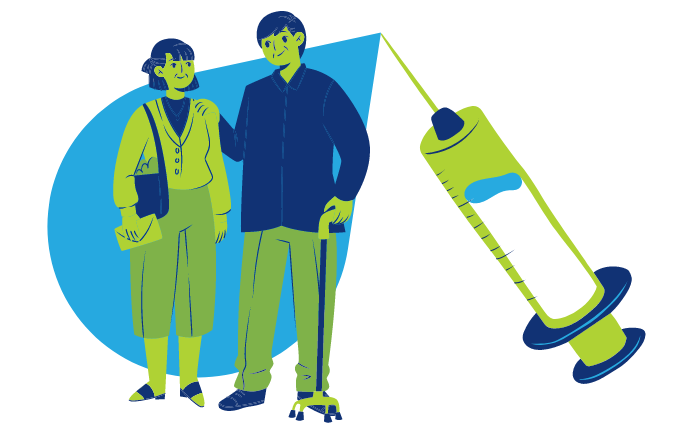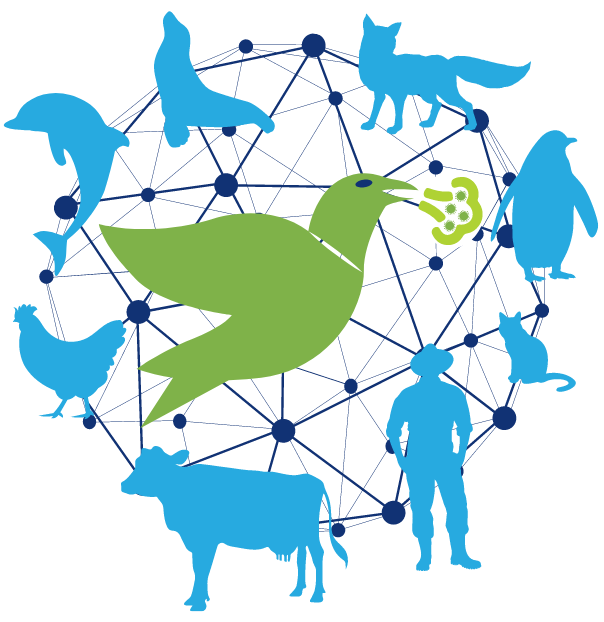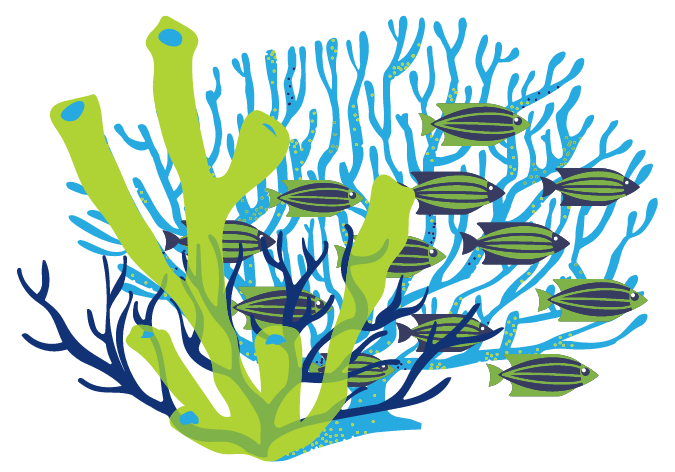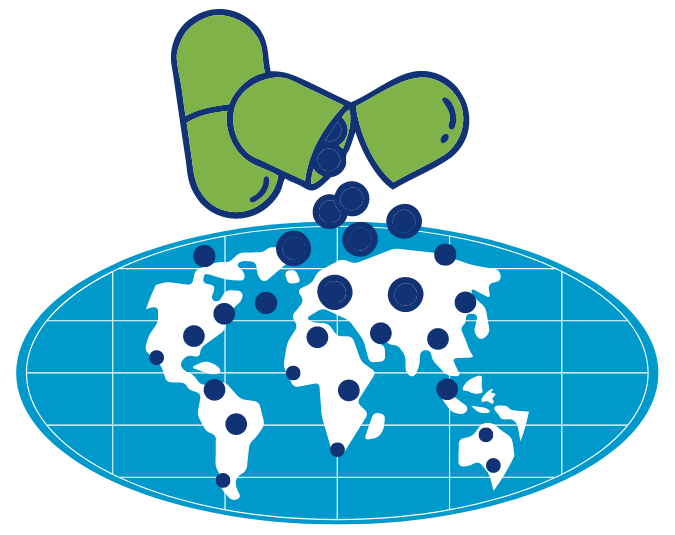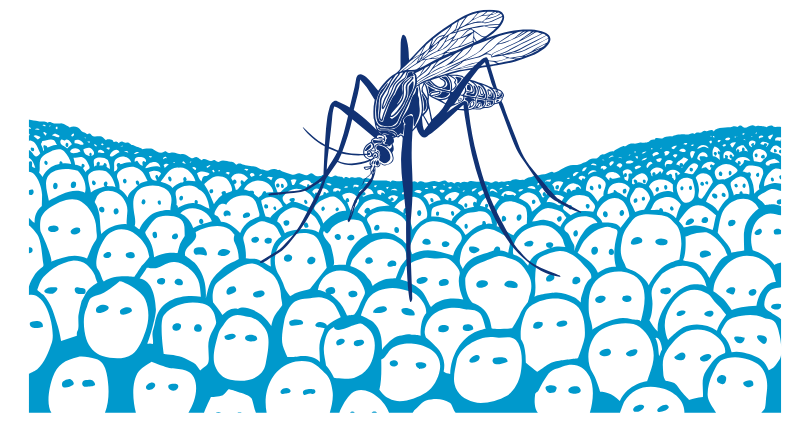
A walk in the woods can bring serenity and peace of mind. You can bring back souvenirs such as a beautiful leaf, or a pine cone. Sometimes your souvenir is less lovely – a tick. Dogs, cats, and even horses can suffer from tick bites and responsible pet owners regularly check their companions for these unwelcome parasites.
Ticks can carry and transmit bacteria, viruses, and parasites that cause Lyme disease, anaplasmosis, Powassan virus, babesiosis, and erlichiosis.
Climate change is making new regions more tick-friendly, which is bad news for people and animals.
Dr. Katie Clow is an Assistant Professor in One Health in the Department of Population Medicine at the Ontario Veterinary College at Canada’s University of Guelph. She’s working on better ways to track ticks and their spread. She’s also got a website with useful information about ticks for people and pet owners.
In this episode of One World, One Health, listen as Katie explains why people need to keep an eye out for ticks, why simply clearing wildlife such as deer won’t help control ticks, and how climate change is helping ticks thrive in more regions of the world.
Maggie Fox
Hello and welcome to One World, One Health, with the latest ideas to improve the health of our planet and its people. I’m Maggie Fox. All of us are facing problems such as pollution, climate change, and new and reemerging infectious diseases, and they are all linked. This podcast is brought to you by the One Health Trust, with bite-sized insights into ways to help.
Climate change is causing all sorts of problems from severe storms and flooding to heat waves and droughts. Warming temperatures can also boost populations of mosquitoes and other creatures that can spread diseases, notably ticks. Dr. Katie Clow, of the Ontario Veterinary College at the University of Guelph, has been studying the spread of ticks and the diseases they carry, including Lyme disease.
In this episode, we’re chatting with Katie about some of her findings and what they mean for us in our pets. Katie, thanks so much for joining us today.
Katie Clow
It’s great to be here, Maggie, thank you.
Maggie Fox
First off, can you tell us a little bit about some of the diseases that ticks carry?
Katie Clow
So there are lots of diseases that can result from tick bites. There’s a long list of different viruses and bacteria and parasites that can be found in ticks, and then depending on the host that gets bitten, so what species, disease may result. What’s in a tick is very dependent on the tick species. And so we know that certain species can transmit certain things while others can’t, and then those risks vary markedly by geography. Wo we have different risks depending on what country you’re in, and what kind of habitats you frequent, and therefore what ticks you might be exposed to.
Maggie Fox
So people generally know about Lyme disease. But can you talk about some of the other diseases that ticks transmit to people?
Katie Clow
Yeah, so certainly, as you know, I’m based in Ontario, Canada, and we have a certain population of ticks that we worry about. The blacklegged tick is the most important tick that we’re worried about for people and our pets. And this tick, in addition to spreading the bacteria that can cause Lyme disease, can spread one type of Anaplasma bacteria that can cause anaplasmosis in people and dogs and cats and horses.
There’s some other pathogens that we find in them as well that are also a risk to human health, such as Powassan virus, which can cause encephalitis in people, Babesia microti, which can cause babesiosis in people. And so all of these things are ones that we’re monitoring. There are other tick populations in the United States that have all sorts of other things in them too. For example, the lone star tick, which we don’t find in Ontario yet — we’re monitoring a lot — but that tick can spread different types of the Ehrlichia bacteria and therefore is a risk for ehrlichiosis in people and pets.
Maggie Fox
Can you tell us a little bit about some of these diseases? Anaplasmosis — what does that do to people and pets?
Katie Clow
I’m a veterinarian, so most of my work is in animals. So for anaplasmosis, we see it in pets, generally they’re just really not feeling well. They can have muscle pain, experienced lameness, fever, not eating, so generally just really not doing very well.
Maggie Fox
And can you tell us a bit more about Powassan virus?
Katie Clow
Powassan virus doesn’t affect animals. We don’t see clinical disease in our companion animals, but in people it can cause encephalitis, which can be fatal, unfortunately. It’s very rare, but it’s something that we’re interested in because the consequences of getting it are so bad.
Maggie Fox
Encephalitis is a swelling of the brain, and that’s very serious.
Katie Clow
Yes, absolutely. Yeah.
Maggie Fox
How are changes in average overall temperatures affecting the distribution of ticks?
Katie Clow
So we’ve particularly seen this in Canada where, if we go back 20, 30 years, our summers were warm, but ticks didn’t have a long enough period to feed, go through their reproductive and development cycle, and then feed again, in order to survive in the environment. As the temperatures are getting warmer and our summers are getting longer, and that period where ticks can feed, develop, [and] feed again, has gotten longer.
So previously ticks, they would have been introduced — they come in on migratory birds all the time. But a lot of times they would just starve out because there wasn’t a period of temperature warm enough for them to be active, out, and feeding. But now, we’re seeing in many of our more northern areas that those temperatures are suitable for them to be active, feeding, [and] reproducing, and now we have [a] northward range expansion of particularly the blacklegged tick, where we’re finding the tick in new areas every year.
Maggie Fox
And these ticks, they can bite dogs and horses and other livestock as well, right?
Katie Clow
Yes. So depending on the tick species, some species have feeding preferences, and others are more indiscriminate feeders, so they’ll essentially feed on most things that have blood. For the blacklegged tick, we find that immature life stages, so the larva, which are the ones that hatch out of the eggs, and then the nymph, which I equate to the teenager life stage, generally feed on birds, small mammals, but we can find them on dogs and cats and people. And then the adults generally like to feed on things that are a bit bigger. They get a bigger blood meal. So of course, deer, blacklegged ticks like to feed on deer, which is where they get their other name from, the deer tick. [They feed on] dogs, cats, and humans as well.
Maggie Fox
Some people worry that because these ticks feed on deer that somehow deer are causing their spread. And if you just got rid of all the deer, you get rid of the ticks. Is that true?
Katie Clow
No. So previously, I think 20, 30, maybe 40 years ago, a lot of research in the state looked at reducing and controlling deer populations in an effort to decline the tick population, because even though white tailed deer, they don’t have the bacteria that causes Lyme disease and so they’re not important parts of the disease transmission cycle, but they’re really important for a vibrant tick population. And there’s lots of research that shows that when deer density is high, the abundance of ticks is high.
But in efforts to sort of reduce the deer population, they weren’t very successful in keeping the tick population down. The only place that seems to work is in a very controlled, small area where you can continually make sure that deer aren’t there versus in a natural sort of open habitat. You can’t really keep the deer population down to the level that it needs to be, which is very, very low. Deer have other ecological benefits as well, and so it’s not a great One Health solution, right? If we think about that, and so it’s not something that’s pursued anymore. Certainly deer are an important part of the story and for understanding ecology. But they’re not…getting rid of the deer is not a suitable mechanism for us controlling Lyme disease.
Maggie Fox
You mentioned a One Health approach. What would a One Health approach to controlling ticks look like?
Katie Clow
I think One Health is very relevant when we’re talking about ticks and tick-borne diseases, because we need collaboration across disciplines. And so myself as a veterinarian, certainly, I have animal health in mind. Physicians have human health in mind. There are a lot of environmental changes that are happening that are facilitating tick populations. And certainly we can’t target one aspect [while] forgetting about the others. There can be a lot that is learned between veterinarians and physicians by communicating about tick risk. Certainly veterinarians, when they’re talking about tick risk to pets, they can talk about it for humans as well, and same with physicians.
Prevention is fairly similar across the board. There are differences between species, but talking about tick checks, and all of those sorts of things is relevant. And then certainly, if we think about a wide scale understanding of the tick population, there’s not one thing that we can do — take out a wildlife population or destroy our forests so that ticks don’t have habitat. Those aren’t feasible solutions, because we’re part of a broader ecosystem where forests and wildlife have inherent value and important value. So we need to understand the ecology, we need to work together to understand that, we need to work together for education. And then it’s really about innovative solutions and controlling tick populations, which we’re still not there on a broad scale. But thinking about the ecology and those impacts and working together using a One Health approach will really help us get there.
Maggie Fox
Because, as you mentioned, you keep talking about the cycle. This isn’t a case of just the virus being in the tick and the tick bites someone — it has to go through several iterations of development, correct?
Katie Clow
Absolutely. Ticks have various life cycles, they’re feeding on different creatures in each life cycle, they pick up the pathogen generally from the creature that they’re feeding on. And so it’s highly complex, and that’s why we really need an integrated approach because we’re not going to understand it by looking simply through one lens or another lens.
Maggie Fox
How do you even keep track of what’s going on with all these ticks that are living on all these different animals?
Katie Clow
We do quite a bit of surveillance and there’s different ways that tick populations are tracked. Passive surveillance is something that maybe many of the audience, viewers are familiar with, and that’s when you find a tick on yourself or your pet, you can report it to the health unit, to different research avenues.
In Canada, we have something called etick.ca, where you can take a picture and upload it, and then all of those submissions are tracked. And we run passive surveillance studies where we have participating veterinary clinics and they’ll submit ticks from the pets that come in. That’s a great way for us to get a large number of ticks to look at what the patterns are without a huge investment in time [or] going out into the field.
But doing fieldwork is really important for confirming if a tick population is there and then understanding changes over time. We go out in the field quite a bit to do tick dragging, which is essentially like you’re dragging a flannel cloth and the vegetation and the ticks stick to it. And we can count the ticks and standardize that and we can test them for pathogens and we know what’s going on.
In Canada, we have a National Sentinel Surveillance Network, where we have sites across the country where every year we’re doing tick drag. It’s a huge collaborative effort, as you can imagine, Canada is a big country. We have over 200 sites that we visit each year. But it’s giving us this really great longitudinal data set where we can follow tick populations, blacklegged ticks and other ticks, and what they’re carrying over time.
Maggie Fox
And you’ve got a website yourself that helps people learn about ticks and monitor them.
Katie Clow
Yeah, we have petsandticks.com. We used to have a pet tick tracker as part of that website. But our lab now collaborates with etick.ca, and everything just goes to E-tick which is great. We have pets and people all in the same spot and we can learn about that together. There’s some educational resources up there, and we’re hoping to boost that over the summer as well as we’ve gotten some funding to focus more on the educational aspect of the website.
Maggie Fox
This greater distribution of ticks, it might bring ticks to people who aren’t normally aware of them. How much of a problem is that?
Katie Clow
Education and tick awareness is really the most important thing we can do. We don’t have a ton of great tools in our toolbox for preventing tick-borne disease other than having people knowledgeable about ticks and making sure that if they go out into tick habitat — so that varies based on the tick but we’re really thinking brushy, natural areas — that they are covering up and applying insect repellent, which can have some effectiveness against ticks staying in places where it’s not as brushy so unmarked trails, and then making sure you do a really good tick check when you get home. If anything is on you, you’re removing it as quickly as possible.
Then for our pets, tick checks are really important too. Cats and dogs also have the benefit that there are things they can take each month from their veterinarian that will kill ticks that bite them. And that’s sort of the first line of prevention that we recommend for our companion animals. But it requires education for everybody to know that those risks exist and certainly as tick populations are expanding into new areas, that education needs to be ongoing because people won’t know that it’s a risk until it’s potentially too late.
Maggie Fox
Katie, thanks so much for taking the time to chat with us.
Katie Clow
Thank you for having me, Maggie.
Maggie Fox
If you liked this podcast, which is brought to you by the One Health Trust, please share it by email or on social media. And let us know what else you’d like to hear about at [email protected]. Thanks for listening.
Ramanan Laxminarayan
Thank you for listening to One World One Health brought to you by the One Health Trust. I’m Ramanan Laxminarayan, founder and president of the One Health Trust. You can subscribe to One World, One Health on Spotify, Apple Podcasts, or wherever you listen to podcasts. Follow us on social media at @onehealthtrust, one word, for updates on One World, One Health and the latest in research on One Health issues, like drug resistance, disease spillovers, and the social determinants of health. Finally, please do consider donating to the One Health Trust to support this podcast and other initiatives and research that help us promote health and wellbeing worldwide. Until next time.
Transcribed by https://otter.ai
Maggie Fox 00:01
Hola y bienvenidos a One World, One Health, con las últimas ideas para mejorar la salud de nuestro planeta y su gente. Soy Maggie Fox.
Todos nos enfrentamos a problemas como la contaminación, el cambio climático y enfermedades infecciosas nuevas y reemergentes, y todo están relacionado. Este podcast es presentado por One Health Trust, con información breve sobre formas de ayudar. El cambio climático está causando todo tipo de problemas, desde fuertes tormentas e inundaciones hasta olas de calor y sequías. El aumento de las temperaturas también puede aumentar las poblaciones de mosquitos y otras criaturas que pueden transmitir enfermedades, en particular las garrapatas. La Dra. Katie Clow, de Ontario Veterinary College at the University of Guelph, ha estado estudiando la propagación de las garrapatas y las enfermedades que transmiten, incluida la enfermedad de Lyme. En este episodio, conversamos con Katie sobre algunos de sus hallazgos y lo que significan para nosotros en nuestras mascotas. Katie, muchas gracias por acompañarnos hoy.
Katie Clow 00:56
Es genial estar aquí, Maggie, gracias.
Maggie Fox 00:59
En primer lugar, ¿puede contarnos un poco sobre algunas de las enfermedades que transmiten las garrapatas?
Katie Clow 01:03
Bien, hay muchas enfermedades que pueden resultar de las picaduras de garrapatas. Hay una larga lista de diferentes virus, bacterias y parásitos que se pueden encontrar en las garrapatas y, dependiendo del huésped que sea picado, que especie y enfermedad puede resultar. Lo que hay en una garrapata depende en gran medida de la especie de garrapata. Entonces sabemos que ciertas especies pueden transmitir ciertas cosas mientras que otras no, y esos riesgos varían notablemente según la geografía. Tenemos diferentes riesgos dependiendo del país en el que te encuentres, del tipo de hábitats que frecuentas y, por tanto, a qué garrapatas podrías estar expuesto.
Maggie Fox 01:48
La gente generalmente conoce la enfermedad de Lyme. Pero, ¿puedes hablarnos de algunas de las otras enfermedades que las garrapatas transmiten a las personas?
Katie Clow 01:54
Sí, ciertamente, como saben, vivo en Ontario, Canadá, y tenemos una cierta población de garrapatas que nos preocupa. La garrapata de patas negras es la garrapata que más nos preocupa para las personas y nuestras mascotas. Y esta garrapata, además de propagar la bacteria que puede causar la enfermedad de Lyme, puede transmitir un tipo de bacteria Anaplasma que puede causar anaplasmosis en personas, perros, gatos y caballos. También encontramos en ellos otros patógenos que también suponen un riesgo para la salud humana, como el virus Powassan, que puede provocar encefalitis en las personas, y Babesia microti, que puede provocar babesiosis en las personas. Y todas estas cosas son las que estamos monitoreando. Hay otras poblaciones de garrapatas en los Estados Unidos que también contienen todo tipo de cosas más. Por ejemplo, la garrapata de la estrella solitaria, que aún no encontramos en Ontario (estamos monitoreándola mucho), pero esa garrapata puede propagar diferentes tipos de la bacteria Ehrlichia y, por lo tanto, representa un riesgo de ehrlichiosis en personas y mascotas.
Maggie Fox 02:58
¿Puedes contarnos un poco sobre algunas de estas enfermedades? Anaplasmosis: ¿qué efecto tiene en las personas y las mascotas?
Katie Clow 03:03
Soy veterinaria, por lo que la mayor parte de mi trabajo es con animales. Entonces, en el caso de la anaplasmosis, que vemos en las mascotas, generalmente simplemente no se sienten bien. Pueden tener dolor muscular, experimentar cojera, fiebre, no comer, por lo que, en general, no les va muy bien. ¿Y puedes contarnos un poco más sobre el virus Powassan? El virus Powassan no afecta a los animales. No vemos enfermedades clínicas en nuestros animales de compañía, pero en las personas puede causar encefalitis, que desafortunadamente puede ser fatal. Es muy raro, pero es algo que nos interesa porque las consecuencias de padecerlo son muy malas.
Maggie Fox 03:47
La encefalitis es una inflamación del cerebro y eso es muy grave.
Katie Clow 03:52
Si, absolutamente. Sí.
Maggie Fox 03:55
¿Cómo afectan los cambios en las temperaturas generales promedio a la distribución de las garrapatas?
Katie Clow 04:00
Hemos visto esto particularmente en Canadá, donde, si retrocedemos 20 o 30 años, nuestros veranos eran cálidos, pero las garrapatas no tenían un período lo suficientemente largo para alimentarse, pasar por su ciclo reproductivo y de desarrollo, y luego alimentarse nuevamente, para sobrevivir en el medio ambiente. A medida que las temperaturas se vuelven más cálidas y nuestros veranos se hacen más largos, el período en el que las garrapatas pueden alimentarse, desarrollarse y volver a alimentarse se ha alargado
Anteriormente las garrapatas se habrian introducido en las aves migratorias todo el tiempo. Pero muchas veces simplemente se morían de hambre porque no había un período de temperatura lo suficientemente cálida para que pudieran estar activos, afuera y alimentándose. Pero ahora, estamos viendo en muchas de nuestras áreas más al norte que esas temperaturas son adecuadas para que estén activas, alimentándose, y reproduciéndose, y ahora tenemos expansión del área de distribución hacia el norte, particularmente de la garrapata de patas negras, donde cada año encontramos la garrapata en nuevas áreas.
Maggie Fox 05:00
Y estas garrapatas también pueden morder a perros, caballos y otros animales, ¿verdad?
Katie Clow 05:06
Sí, dependiendo de la especie de garrapata, algunas especies tienen preferencias alimentarias y otras se alimentan de manera más indiscriminada, por lo que esencialmente se alimentarán de la mayoría de las cosas que tienen sangre. Por la garrapata de patas negras encontramos etapas de vida inmaduras, la larva, que son las que salen de los huevos, y luego la ninfa, que equivale a la etapa de vida adolescente, generalmente se alimentan de aves, pequeños mamíferos, pero podemos encontrarlos en perros, gatos y personas. Y las adultas generalmente les gusta alimentarse de cosas que son un poco más grandes. Reciben una mayor ingesta de sangre. Por supuesto, a las garrapatas de los venados les gusta alimentarse de venados, de ahí su otro nombre, garrapata de los venados. Se alimentan de perros, gatos y humanos también.
Maggie Fox 05:51
A algunas personas les preocupa que, debido a que estas garrapatas se alimentan de ciervos, de alguna manera los ciervos estén causando su propagación. Y si simplemente te deshaces de todos los ciervos, te deshaces de las garrapatas. ¿Es verdad?
Katie Clow 06:01
No, creo que hace 20, 30, tal vez 40 años, muchas investigaciones en el estado buscaban reducir y controlar las poblaciones de venados en un esfuerzo por disminuir la población de garrapatas, porque a pesar de que los venados de cola blanca, no tienen las bacterias que causan la enfermedad de Lyme y, por lo tanto, no son parte importante del ciclo de transmisión de la enfermedad, pero son muy importantes para una población de garrapatas. Y hay muchas investigaciones que muestran que cuando la densidad de ciervos es alta, la abundancia de garrapatas es alta. Pero en sus esfuerzos por reducir la población de ciervos, no tuvieron mucho éxito en mantener baja la población de garrapatas. El único lugar que parece funcionar es en un área pequeña y muy controlada donde puedes asegurarte continuamente de que no haya ciervos allí, en comparación con un hábitat natural abierto. Realmente no se puede mantener la población de ciervos al nivel necesario, que era muy, muy bajo. Los ciervos también tienen otros beneficios ecológicos, por lo que no es una gran solución de “Salud única”, ¿verdad? Si pensamos en eso, no es algo que se persiga. Ciertamente los ciervos son una parte importante de la historia y para entender la ecología. Pero no van a deshacerse… de los ciervos, no es un mecanismo adecuado para que podamos controlar la enfermedad de Lyme.
Maggie Fox 07:27
Mencionaste un enfoque de “Salud única” ¿Cuál sería el enfoque de “Salud única” para controlar las garrapatas?
Katie Clow 07:32
Creo que “Salud única” es muy pertinente cuando hablamos de garrapatas y enfermedades transmitidas por garrapatas, porque necesitamos colaboración entre disciplinas. Y yo, como veterinaria, ciertamente tengo en mente la salud animal. Los médicos tienen en mente la salud humana. Se están produciendo muchos cambios ambientales que están facilitando las poblaciones de garrapatas. Y ciertamente no podemos centrarnos en un aspecto mientras nos olvidamos de los demás. Se puede aprender mucho entre veterinarios y médicos al comunicarse sobre el riesgo de garrapatas. Ciertamente, los veterinarios, cuando hablan del riesgo de garrapatas para las mascotas, también pueden hablar de ello para los humanos, y lo mismo con los médicos. La prevención es bastante similar en todos los ámbitos. Hay diferencias entre especies, pero hablar de controles de garrapatas y todo ese tipo de cosas es relevante. Y luego, si pensamos en comprender a gran escala la población de garrapatas, no hay nada que podamos hacer: eliminar una población de vida silvestre o destruir nuestros bosques para que las garrapatas no tengan un hábitat, esas no son soluciones factibles, porque somos parte de un ecosistema más amplio donde los bosques y la vida silvestre tienen un valor inherente y un valor importante. Necesitamos entender la ecología, necesitamos trabajar juntos para entender eso, trabajar juntos por la educación. Y luego se trata realmente de soluciones innovadoras y de controlar las poblaciones de garrapatas, algo que todavía no hemos logrado a gran escala. Pero pensar en la ecología y el impacto y trabajar juntos utilizando el enfoque “Salud única” realmente nos ayudará a lograrlo.
Maggie Fox 09:04
Porque, como mencionaste, sigues hablando del ciclo. Este no es un caso en el que el virus está en la garrapata y la garrapata pica a alguien; tiene que pasar por varias etapas de desarrollo, ¿correcto?
Katie Clow 09:15
Absolutamente. Las garrapatas tienen varios ciclos de vida, se alimentan de diferentes criaturas en cada ciclo de vida, generalmente contraen el patógeno de la criatura de la que se alimentan. Por eso es muy complejo y es por eso que realmente necesitamos un enfoque integrado porque no vamos a entenderlo mirándolo simplemente a través de una lente u otra.
Maggie Fox 09:39
¿Cómo puedes seguir la pista de todas estas garrapatas que viven en todos estos diferentes animales?
Katie Clow 09:45
Hacemos bastante vigilancia y hay diferentes formas de rastrear las poblaciones de garrapatas. La vigilancia pasiva es algo con lo que quizás muchos de los espectadores estén familiarizados, y es entonces cuando, si encuentras una garrapata en ti o en tu mascota, puedes informarlo a la unidad de salud, a diferentes vías de investigación. En Canadá, tenemos algo llamado etick.ca, donde puedes tomar una fotografía y subirla, y luego se realiza un seguimiento de todos esos envíos. Y realizamos estudios de vigilancia pasiva en los que contamos con clínicas veterinarias participantes que envían garrapatas de las mascotas que ingresan. Esa es una excelente manera de obtener una gran cantidad de garrapatas para observar cuáles son los patrones sin una gran inversión en tiempo o salir al campo. Pero hacer trabajo de campo es realmente importante para confirmar si existe una población de garrapatas y luego comprender los cambios a lo largo del tiempo. Salimos bastante al campo para arrastrar garrapatas, que es esencialmente como si estuvieras arrastrando un paño de franela y la vegetación y las garrapatas se pegan a el. Y podemos contar las garrapatas y estandarizarlas y podemos analizarlas en busca de patógenos y sabemos qué está pasando. En Canadá, tenemos la National Sentinel Surveillance Network, donde tenemos sitios en todo el país donde cada año realizamos búsquedas de garrapatas. Es un esfuerzo de colaboración enorme. Como puedes imaginar, Canadá es un país grande. Tenemos más de 200 sitios que visitamos cada año. Pero nos está brindando este excelente conjunto de datos longitudinales donde podemos seguir las poblaciones de garrapatas, garrapatas de patas negras y otras garrapatas, y lo que transportan a lo largo del tiempo.
Maggie Fox 11:21
Y tienes un sitio web que ayuda a las personas a aprender sobre las garrapatas y controlarlas.
Katie Clow 11:26
Sí, tenemos petsandticks.com. Solíamos tener un rastreador de garrapatas para mascotas como parte de ese sitio web. Pero nuestro laboratorio ahora colabora con etick.ca, y todo va directamente a etick, lo cual es fantástico. Tenemos mascotas y personas en el mismo lugar y podemos aprender sobre eso juntos. Hay algunos recursos educativos allí y esperamos impulsarlos durante el verano y también hemos obtenido algunos fondos para centrarnos más en el aspecto educativo del sitio web.
Maggie Fox 11:54
Esta mayor distribución de garrapatas podría traer garrapatas a personas que normalmente no son conscientes de ellas. ¿Qué problema hay?
Katie Clow 12:01
La educación y la concientización sobre las garrapatas es realmente lo más importante que podemos hacer. No tenemos muchas herramientas excelentes en nuestra caja de herramientas para prevenir las enfermedades transmitidas por garrapatas, aparte de tener personas con conocimientos sobre las garrapatas y asegurarnos de que, si salen al hábitat de las garrapatas, eso varía según la garrapata, pero estamos pensando realmente en áreas naturales con maleza, que están cubriendo y aplicando repelente de insectos, que puede tener cierta efectividad contra las garrapatas que se quedan en lugares donde no hay tanta maleza, como en senderos sin marcar, y luego asegurarse de hacer una muy buena verificación de garrapatas cuando llegar a casa. Si tienes algo encima, lo eliminarás lo más rápido posible. Y para nuestras mascotas, los controles de garrapatas también son muy importantes. Los gatos y los perros también tienen el beneficio de que hay cosas que pueden pedirle a su veterinario cada mes que matarán las garrapatas que los piquen. Y esa es la primera línea de prevención que recomendamos para nuestros animales de compañía. Pero se requiere educación para que todos sepan que esos riesgos existen y, ciertamente, a medida que las poblaciones de garrapatas se están expandiendo a nuevas áreas, esa educación debe ser continua porque la gente no sabrá que es un riesgo hasta que sea demasiado tarde.
Maggie Fox 13:19
Katie, muchas gracias por tomarte el tiempo de charlar con nosotros.
Katie Clow 13:22
Gracias por invitarme, Maggie.
Maggie Fox 13:24
Si le gustó este podcast, presentado por One Health Trust, compártalo por correo electrónico o en las redes sociales. Y háganos saber qué más le gustaría saber en [email protected] . Gracias por su atención.
Guest

Dr. Katie Clow is a veterinarian and Assistant Professor in One Health in the Department of Population Medicine at the Ontario Veterinary College, University of Guelph. Her research focuses on the ecology and epidemiology of vector-borne and zoonotic diseases. She also conducts research more broadly on One Health, including pedagogy.
Credits
Hosted and written by Maggie Fox
Special guest: Katie Clow
Produced and edited by Samantha Serrano
Music composed and sound edited by Raquel Krügel
Transcript edited by Aditi Satyavrath

